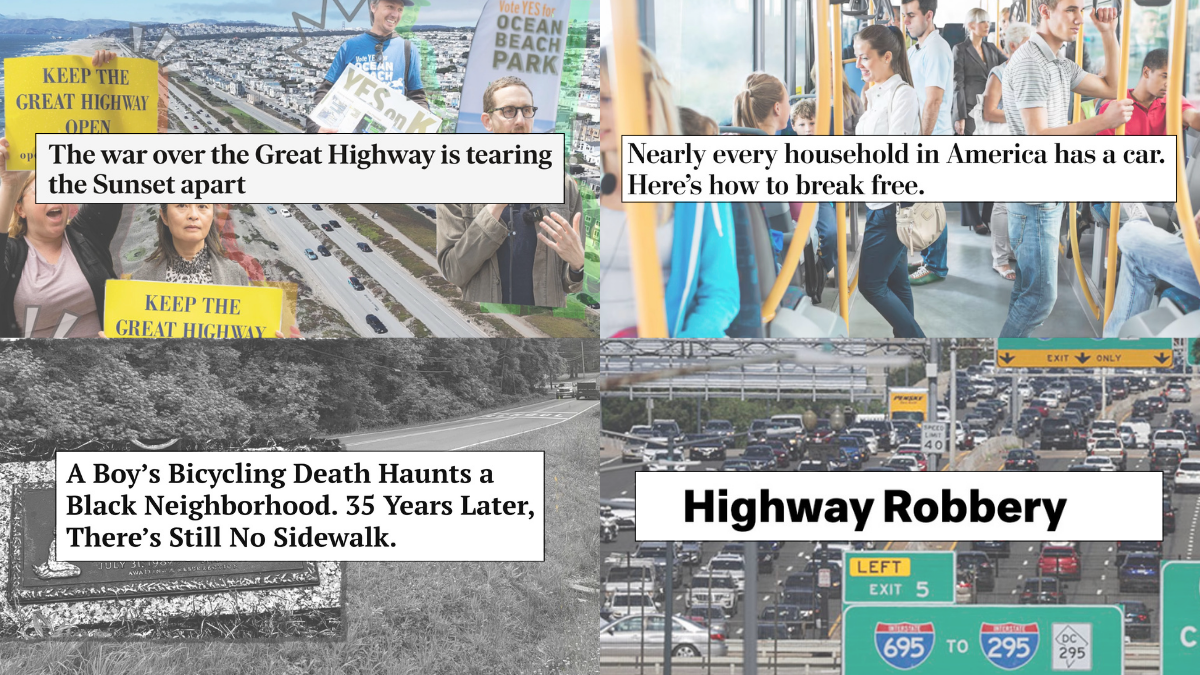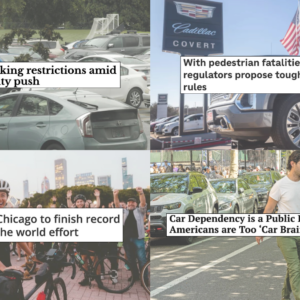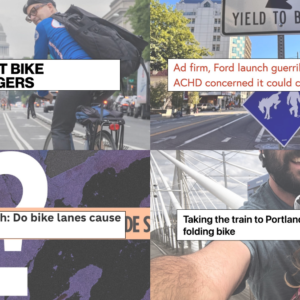It’s Monday! Time to round up the best news and stories from the past week…
Mad about models: This week’s must-read is a breakdown of very troubling traffic modeling used by DOTs and highway builders to justify spending billions on megaprojects just like our very own freeway expansion between Portland and Vancouver. This article dovetails perfectly with part of the conversation between Je Amaechi and I last week. (Dissent Magazine)
**Sponsored by The EBike Store**

Sidewalks matter: A haunting story about a six-year-old boy who was killed by a driver on a road in a Black neighborhood without sidewalks 35 years ago. (KFF Health News)
A carfree status report: Always interesting when a mainstream media outlet parachutes into our world. In this case, a reporter talked to Americans who’ve — shock! — managed to give up a car and not regret it. I like how the takeaway is that, given the choice, most people would be happy to live low-car or carfree lives. (The Washington Post)
College paper chimes in on Willamette bike lanes: PBOT’s big project to change the design of N Willamette Blvd is directly adjacent to University of Portland and the college’s newspaper reports why students are watching its progress closely. (The Beacon)
Speed limits during races: Interesting situation has bubbled up in the UK after authorities establish 20 mph zones and organizers of cycling races must detour around the zones in order to keep their caravans in compliance. (Cycling Weekly)
Lessons learned: I’ve been a fan of Russ Roca since the early days of BikePortland and it’s been amazing to watch him grow into such a respected YouTuber while not compromising his vision or independence. His recent post on things in his life and the bike industry he wished he’d known sooner is well worth watching. (Path Less Pedaled on YouTube)
War for a carfree road: The battle playing out in San Francisco over a measure that would permanently prohibit drivers from using a portion of a coastal road is just the latest example of how deeply some people resist change — especially when it involves cars. (The San Francisco Standard)
For the record: I was happy to at see our state’s main news outlet attempt to correct the record about the type of vehicle a Tigard teen was riding when he was killed on a road in Tualatin last week, but then the article still mentions “e-bike” so many times I’m not sure it really helps much. (The Oregonian)
Thanks to everyone who sent in links this week. The Monday Roundup is a community effort, so please feel free to send us any great stories you come across.







Thanks for reading.
BikePortland has served this community with independent community journalism since 2005. We rely on subscriptions from readers like you to survive. Your financial support is vital in keeping this valuable resource alive and well.
Please subscribe today to strengthen and expand our work.
There’s an interesting tidbit in the Cycling Weekly article on 20mph speed limits affecting race caravans:
Is that common? What other countries or municipalities exempt cyclists from speed limits? What are the laws here?
It is a historical artifact since “most” bicycles did not have a speedometer or even as an OEM feature and was moot (as a problem), that is until e-bikes became a predominate bike type.
The ‘sliver of silver lining’ of ebike’s power and speed is that they have head and tail lamps as a factory installed feature vs as an aftermarket option. (Most non e-bike riders I see in Honolulu and in Vancouver still operate without a headlamp.)
College paper chimes in on Willamette bike lanes –
Why not make the whole length of Willamette Blvd. one way..one lane of car traffic?
A “car free” status report?
From the WAPO piece:
“Car free” family #1
“Car free” family #2
Purchasing a toxic lithium “rare earth” battery is worse that driving a gas-guzzling SUV.. It’s time to stop buying things and give “zero car” degrowth a try.
I have no objections to “zero car” but I do object to misinformation.
Lithium is neither especially rare nor toxic (especially not compared to the lead found in that SUV battery). Nor are EVs tied to Li: sodium batteries, which, though less efficient in terms of charge/kg, can be rapidly charged and may turn out to be cheaper.
One car company in China is already selling car based on these, and Tesla has announced plans to start producing them. And they aren’t exactly exotic: you can buy your own sodium cells on AliExpress today.
https://www.farasis-energy.com/en/the-worlds-first-ev-powered-by-farasis-energys-sodium-ion-batteries-rolls-off-the-assembly-line
A list of actual “rare earth” elements can be found here: https://en.wikipedia.org/wiki/Rare-earth_element
Credit the Oregonian: They used the phrase “high speed products called e-bikes” once and another time gave a detailed description of the 2000 watt machine. Every other mention was either a quote from a police report or from state law.
I notice that the Class 3 description was different from what I’ve seen before. The article states that on a Class 3 bike throttle operation is limited to 20 mph but the bike can be pedal assisted to 28 mph.
The Oregonian article got it wrong. Class 3 ebikes cannot have a throttle. Oregon law (HB4103) defines Class 3 ebikes as only providing assistance when the rider is pedaling, and makes no mention of a 20mph threshold.
Well, not yet. HB4103 is still in the R&D phase. https://www.oregon.gov/oprd/prp/pages/prp-rule-2024-ebikes.aspx
From the table in that article all three classes are allowed a nominal 1000 watt motor. It makes some sense to standardize hardware but that’s a lot of acceleration on a single bike. With the wrong controller settings an unwary rider could easily crash well before they reached 20 mph.
A motor designed to draw 500 watts can push a pedal assist single bike up to 28 mph, no problem.
When are people going to notice that these ‘bikes’ are really heavy?
College paper chimes in…
It’s an interesting article, but I wondered about one word choice.
“On campus, there’s been an average of one near-campus motor vehicle crash implicating cyclists or pedestrians a year…”
Would ‘involving’ have been better?
I have been lucky enough to live in places where I could live car free for most of my adult life. I recently sold my car and it feels like a weight has been lifted off of me. The small burdens really added up for me and I feel so much happier just walking and biking around. But it’s only possible because I live in an area where I can walk to meet all of my daily needs.
There’s a side social benefit, too. Just this weekend I ran into like a dozen friends and acquaintances while walking around. These spontaneous little encounters bring me a lot of joy.
One of the best things about biking is when you run into a dozen friends with your bike, it’s a happy coincidence. When you do that in a car it’s a tragedy.
Lessons learned: great video. Stuff I wish I knew when younger:
Getting old hurts, literally. All those bike injuries come back to haunt you.
700c isn’t metric, it’s a size on a 1930s chart (there’s also a 700a, 700b, etc). 622mm is the metric measurement, from just inside the rim where the tire rests; 28″ and 29″ are also 622mm, just wider and bigger.
26×1 3/8ths is not the same as 26×1.375 on tires, their metric sizes are radically different. Same with 27×1 1/4 versus 700×28. Different sized rims.
1987-self, don’t buy any cartridge hubs, those ball bearing hubs can last over 40 years, as long as they are properly maintained and adjusted.
It’s possible to buy a bullet-proof tire, Schwalbe, Continental, CST, Kenda, Michelin, Panaracer, etc, they all make them, very popular in Europe, harder to find in the USA.
9 and 10 speed chains work just fine on 8 speed cassettes, ebike chains last longer.
Well, not quite: 700C *is* a metric size, in that it was one of several sizes where the inflated diameter of the tire was 700 millimeters. The 700A, 700B, 700C, and 700D were increasing tire widths, with correspondingly decreasing rim diameters. So strictly speaking, a 700C is exactly one tire size, called 40-622 using ISO terminology (that is, its inflated *width* is 40 mm and its bead seat diameter is 622 mm). Calling any other ISO 622 tire “700C” is an anachronism.
While we’re at it, there are actually *two* different rims whose tires are called 26 x 1 3/8″–a 590 mm bead seat diameter, and a 597. There are at least five different rim diameters that are called “26 inches”–it’s the most tricky size.
I wish we’d all just speak in ISO.
Thanks for coming to my Tire(d) Talk.
Sidewalks matter: In most of NC, it’s up to the municipality to put in and maintain the sidewalk, not the property owner, including in Durham NC, a wealthy city that is home to Duke University. As much as Durham was segregated through the 60s and still is more-or-less divided by race, it’s not particularly unique in NC or anywhere else for that matter, and even its mostly white parts of town lack sidewalks and safe crossings, while some poor inner-city black areas have excellent sidewalk connectivity. The outer “county” areas of all cities in NC lack sidewalks, they aren’t actually in the city at all.
Many years ago I lived along the Great Highway in the Outer Sunset (adjacent on La Playa St) and while it certainly was convenient to get out of town that way when heading south, using other streets was not that onerous. I would have been in favor of closing it even back then.
However, when I visited last summer the Great Highway was markedly less convenient because it is partially obscured by encroaching sand dunes already. Often the two lanes went down to one, causing a merge that slowed the pace of the “highway” to that of the adjacent streets anyway. From what I understand sometimes the sand conditions temporarily close highway even on the weekdays.
Even if the proposition loses, it’s really only a matter of time before the city decides it is not viable to keep maintaining this portion of the road.
Honestly, if they’re going to list the top assisted speed of the bicycle and then say “we have no idea how fast they were going” then every traffic crash should be reported this way.
“Single vehicle collision on outer SE Division, we don’t know how fast they were going but the car was capable of reaching 155 mph.”
“The car driver was wearing dark clothing and wasn’t wearing a helmet. Investigators are still determining if the driver’s lights were working or not. The hit light pole came out of nowhere.”